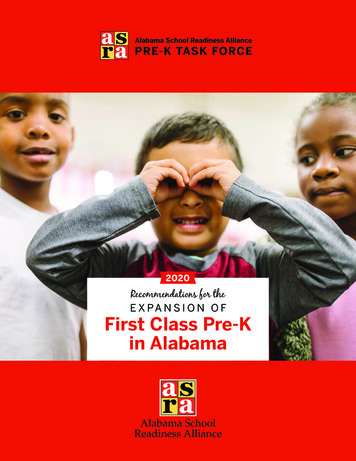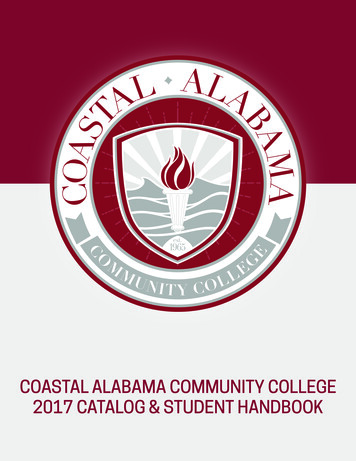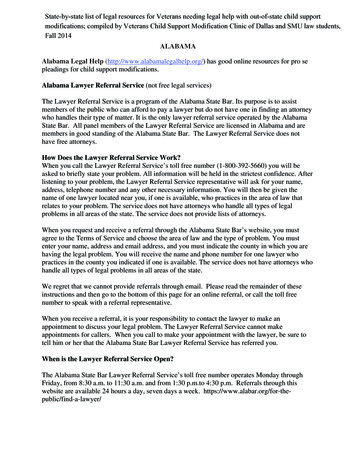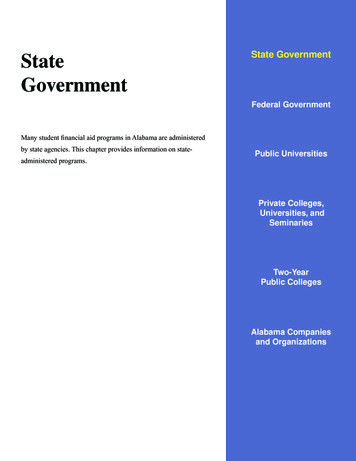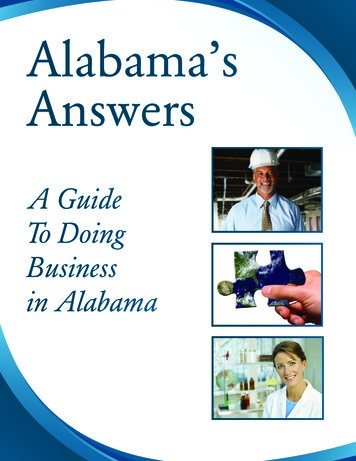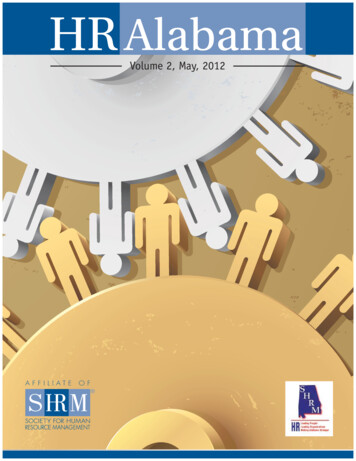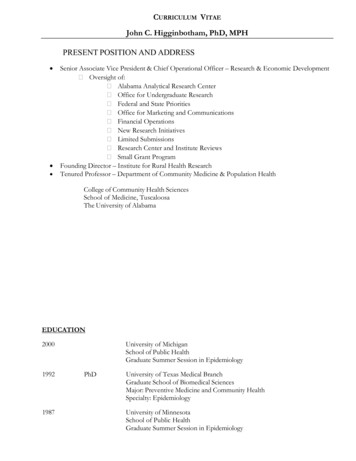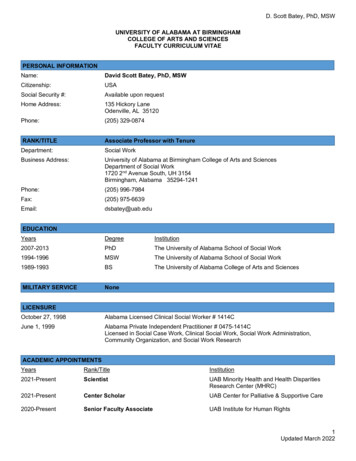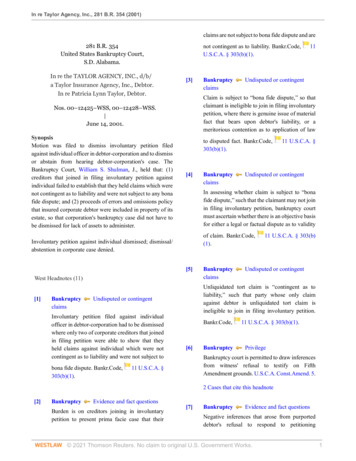
Transcription
In re Taylor Agency, Inc., 281 B.R. 354 (2001)claims are not subject to bona fide dispute and arenot contingent as to liability. Bankr.Code,U.S.C.A. § 303(b)(1).281 B.R. 354United States Bankruptcy Court,S.D. Alabama.In re the TAYLOR AGENCY, INC., d/b/a Taylor Insurance Agency, Inc., Debtor.In re Patricia Lynn Taylor, Debtor.[3]to disputed fact. Bankr.Code,303(b)(1).[4]West Headnotes (11)bona fide dispute. Bankr.Code,303(b)(1).Bankruptcyclaims11 U.S.C.A. § 303(b)Undisputed or contingentUnliquidated tort claim is “contingent as toliability,” such that party whose only claimagainst debtor is unliquidated tort claim isineligible to join in filing involuntary petition.Undisputed or contingentInvoluntary petition filed against individualofficer in debtor-corporation had to be dismissedwhere only two of corporate creditors that joinedin filing petition were able to show that theyheld claims against individual which were notcontingent as to liability and were not subject toUndisputed or contingentof claim. 11 U.S.C.A. §In assessing whether claim is subject to “bonafide dispute,” such that the claimant may not joinin filing involuntary petition, bankruptcy courtmust ascertain whether there is an objective basisfor either a legal or factual dispute as to validityInvoluntary petition against individual dismissed; dismissal/abstention in corporate case denied.[1]Undisputed or contingentClaim is subject to “bona fide dispute,” so thatclaimant is ineligible to join in filing involuntarypetition, where there is genuine issue of materialfact that bears upon debtor's liability, or ameritorious contention as to application of lawNos. 00–12425–WSS, 00–12428–WSS. June 14, 2001.SynopsisMotion was filed to dismiss involuntary petition filedagainst individual officer in debtor-corporation and to dismissor abstain from hearing debtor-corporation's case. TheBankruptcy Court, William S. Shulman, J., held that: (1)creditors that joined in filing involuntary petition againstindividual failed to establish that they held claims which werenot contingent as to liability and were not subject to any bonafide dispute; and (2) proceeds of errors and omissions policythat insured corporate debtor were included in property of itsestate, so that corporation's bankruptcy case did not have tobe dismissed for lack of assets to tcy11 U.S.C.A. § 303(b)(1).PrivilegeBankruptcy court is permitted to draw inferencesfrom witness' refusal to testify on FifthAmendment grounds. U.S.C.A. Const.Amend. 5.11 U.S.C.A. §2 Cases that cite this headnote[2]BankruptcyEvidence and fact questionsBurden is on creditors joining in involuntarypetition to present prima facie case that their[7]BankruptcyEvidence and fact questionsNegative inferences that arose from purporteddebtor's refusal to respond to petitioning 2021 Thomson Reuters. No claim to original U.S. Government Works.1
In re Taylor Agency, Inc., 281 B.R. 354 (2001)creditors' questions were insufficient, standingalone, to constitute probative evidence ofpetitioners' claims, and did not establish thatpetitioners held claims that were not subject tobona fide dispute or contingent as to liability, asrequired for them to join in involuntary petition.U.S.C.A. Const.Amend. 5; Bankr.Code,U.S.C.A. § 303(b)(1).112 Cases that cite this headnote[11]BankruptcyInsurance policies andliabilities thereonDetermination of whether proceeds of debtor'sinsurance policy are property of the estatemust be made in light of facts of each case.Bankr.Code,[8][9]Federal Courtsof proofPresumptions and burden1 Cases that cite this headnoteBurden of proof is on parties seeking abstentionand dismissal under bankruptcy abstentionstatute. Bankr.Code, 11 U.S.C.A. § 305.Attorneys and Law Firms4 Cases that cite this headnote*356 William H. Hardy, Jr., Mobile, AL, for Siuprem, Inc.Federal CourtsBankruptcyCarol H. Stewart and Michael Leo Hall, Birmingham, AL, forMorgan Premium Finance, Inc.Federal CourtsDispositionDismissal or OtherFederal CourtsStayBankruptcy abstention provision, that permitscourt to dismiss case or suspend proceedingswhere interests of debtor and creditors would bebetter served thereby, is applied very narrowly,and dismissal or suspension is proper onlyin extraordinary circumstances. Bankr.Code, 11U.S.C.A. § 305(a)(1).3 Cases that cite this headnote[10]11 U.S.C.A. § 541(a).BankruptcyDismissalDetermination of Issues;BankruptcyInsurance policies andliabilities thereonProceeds of errors and omissions policy thatinsured corporate debtor were included inproperty of its estate, so that corporation'sinvoluntary case did not have to be dismissedfor lack of assets to administer or on theorythat dismissal was in creditors' best interests;because insurance proceeds were included inbankruptcy estate, it was in creditors' bestinterests not to dismiss, so as to prevent race tocourthouse. Bankr.Code, 11 U.S.C.A. §§ 305(a)(1),541(a).Winston R. Grow, Mobile, AL, for American ResourcesInsurance Company.Michael J. Clemmer, Birmingham, AL, for PremiumAssignment Corporation.C. Michael Smith and William A. Kimbrough, Jr., Mobile,AL, for Debtors.ORDERWILLIAM S. SHULMAN, Bankruptcy Judge.This matter came before the Court on the trial of theinvoluntary bankruptcy proceeding filed against the TaylorAgency, Inc., (hereinafter referred to as the “Taylor Agency”),and Patricia Lynn Taylor (hereinafter individually referredto as “Taylor” and jointly referred to as “Debtors”), and themotion of the Debtors requesting that the Court abstain ordismiss the proceedings. After a hearing on the merits, theCourt took this matter under submission.FINDINGS OF FACTThe petitioning creditors, Morgan Premium Finance, Inc.(hereinafter referred to as “Morgan”), American ResourcesInsurance Company ( hereinafter referred to as “American”), 2021 Thomson Reuters. No claim to original U.S. Government Works.2
In re Taylor Agency, Inc., 281 B.R. 354 (2001)and Siuprem, Inc. (hereinafter “ Siuprem”) initiated thisinvoluntary proceeding on June 22, 2000 by filing aninvoluntary petition against Taylor and the Taylor Agency.Premium Assignment Corporation (hereinafter referred to as“Premium”) joined as a petitioning creditor on October 19,2000. The Debtors filed answers to the involuntary petitionand filed motions to abstain or dismiss the proceeding.Premium and American hold judgments against The TaylorAgency totaling over 303,000.00. Morgan and Siupremare insurance premium finance companies that did businesswith the Debtors. The Taylor Agency is a corporation, nowdefunct, that operated as an insurance agency in Gilbertown,Alabama and Taylor was its president.In the course of doing business, the Debtors would puttogether insurance policies for their clients, and Morgan andSiuprem would from time to time, enter into a financialarrangement whereby they would finance the premiums.Drafts or checks would be issued by them to the TaylorAgency on behalf of the insured. These would be deposited ina bank account of the Taylor Agency to be used for paymentof the premium to various insurance companies providinginsurance to the insured.Siuprem filed suit against the Debtors in the United StatesDistrict Court, Southern District of Alabama, in September1999. The complaint alleged that the Debtors negligentlymade advances on behalf of Siuprem and other premiumfinance companies on behalf of the same insured and thatthe Debtors committed fraud in obtaining loans to financethe insurance premiums. In addition, exhibits admitted inevidence reflect a number of checks issued by The TaylorAgency returned for insufficient funds. ( Exhibit SIUP–G). The Taylor Agency agreed to indemnify Suiprem forany losses under the draft authority. (Exhibit SIUP–B).In all, Siuprem has claims against the Taylor Agency forapproximately 517,000.00.*357 Morgan placed into evidence documents that showedthe Taylor Agency liable to Morgan for checks returned forinsufficient funds and for unearned premiums which were dueto be paid back to Morgan when certain insurance contractswere canceled. The approximate amount due to Morgan fromthe Taylor Agency based on these sums totaled 51,000.00plus other fees and charges.The Alabama Department of Insurance filed a 31 countcomplaint against Taylor on February 25, 2000 chargingthat she had violated the Alabama Insurance Codeby making intentional misrepresentations, engaging infraudulent conduct, failing to account for and pay funds overto an insurer, or others, and misappropriating, converting,or unlawfully withholding money belonging to insurers orothers. (See Exhibit MP–14).An emergency order to cease and desist was entered by theAlabama Department of Insurance on February 25, 2000. OnApril 12, 2000, an order was entered upon the default ofTaylor to respond to the complaint. The order found that shehad committed the violations set forth in the complaint, andrevoked her agency and broker licenses. The order furtherrequired that she turn over any funds and premiums which shereceived and held in trust, and also ordered her to reimburseall monies owed to insureds, insurers, or others for moniesowed as a result of the insurance transactions contained in thecomplaint. (Exhibit MP–16).The evidence further shows that Taylor signed insurancepremium finance agreements with both Siuprem and Morganas an agent/broker, whereby she agreed to refund anyunearned commissions and unearned premiums, therebycreating personal liability for at least part of the indebtednessowed by the Taylor Agency. (Exhibit MP–19, 21; ExhibitSiup–D).American submitted into evidence a complaint which wasfiled in the Circuit Court of Mobile County, Alabama againstthe Taylor Agency and Taylor alleging that the TaylorAgency owed American for premiums collected, but notpaid, and for certain commissions which should have beenrefunded to American. Individual liability against Taylor wasclaimed because of an indemnity agreement dated November20, 1991, wherein the complaint alleged Taylor agreed toreimburse American for losses sustained by the failure of theTaylor Agency to make payment to American. (See ExhibitAR–5). The indemnity agreement was executed as follows: “Lynn M. Taylor, Sec.Tres., of the Taylor Agency, Inc.”.The Taylor Agency was issued an errors and omissioninsurance policy by Employer's Reinsurance Corporationcovering the period from May 20, 1999 to May 20, 2000.(See Ex. Siup. M). The named insured is “The Taylor Agency,Inc.”, and the term “insured” is defined in Section V to includethe named insured and any owner, partners, executive officer,or employee of the named insured while acting within thescope of that person's duties. 2021 Thomson Reuters. No claim to original U.S. Government Works.3
In re Taylor Agency, Inc., 281 B.R. 354 (2001)Under the policy, Employers Reinsurance Corporation agreedto pay the liability imposed on the insured for damages causedby:(a) any negligent act, error, or omission of the Insured or anyperson for whose acts the Insured is legally liable .(§ 1(a)).The original exclusions appearing on page 3 of Form ERC1219J were amended by the endorsement PAL–11 whichstates:IT IS AGREED that this policy is extended to cover dishonest,fraudulent, criminal, or malicious acts committed by anemployee of the Named Insured, and *358 paragraph(a) of the section of this policy captioned “Exclusions”is hereby amended accordingly. The coverage provided bythis Endorsement shall extend to the Named Insured andany Insured provided that such insured did not personallyparticipate or ratify the dishonest, fraudulent, or criminal act.The Taylor Agency would appear, therefore, to be insuredagainst dishonest, fraudulent, criminal, or malicious actscommitted by its employee Taylor.Siuprem and Morgan have shown Taylor individually liablepursuant to their premium finance agreements which sheexecuted. However, American relies on the indemnityagreement which was signed by Taylor, but executed in acorporate capacity. The language of the indemnity refers to“we, the undersigned” and the only signature is that of Tayloras secretary–treasurer of the Taylor Agency, Inc. In the caseof Marriott International, Inc. v. deCelle, 722 So.2d. 760(Ala.1998) a creditor sued to collect on a guaranty fromthe debtor's president in his individual capacity. Althoughthe guaranty agreement that deCelle signed was in hisrepresentative capacity as president, the body of the guarantycontract stated that the undersigned “individual” guaranteesthe debt of Sum Big Stores, Inc. The facts in the instant caseare similar. The Alabama Supreme Court reversed the trialcourt which had dismissed the suit. The Court stated that“taken, as a whole, the guaranty contract is inconsistent asto whether Mr. deCelle signed in his representative capacity.Thus, the contract is ambiguous as to whether the partiesintended Mr. deCelle to guarantee the debt in his individualcapacity.” deCelle, 722 So.2d at 763 ( citations omitted).[2] The burden is on the petitioning creditor to establisha prima facie case that there is no bona fide dispute or thatthe claim is not contingent as to the liability. In determiningwhether a creditor's claim is subject to a “bona fide dispute”*359 within the meaning ofCONCLUSIONS OF LAWSection 303(b)(1), the courtshave adopted an objective standard. In theMatter of EarlDISMISSAL UNDER§ 303(b)(1)[1] The Debtors raised in their reply brief the issue that theSims, 994 F.2d 210 (5th Cir.1993); In re Eastown Auto Co.,215 B.R. 960 (6th Cir. BAP 1998).petitioning creditors have not met their burden under[3] [4] A bona fide dispute exists “if there is a genuineissue of material fact that bears upon the debtor's liability,or a meritorious contention as to the application of law to111U.S.C. § 303(b)(1). Specifically, Debtors claim that lessthan three of the petitioning creditors hold a claim against theDebtors that is not contingent as to liability. The facts in thecase clearly show that as to the Taylor Agency, all four ofthe petitioning creditors hold non-contingent claims, some ofwhich are liquidated in the form of a judgment. However, theevidence is less clear with respect to the individual debtor,Patricia Lynn Taylor. Premium had a summary judgmententered against the Taylor Agency and had no resolution ofits suit against Taylor, individually. (See Exhibits PAC 1 and2). Nor was any evidence introduced at trial that would showwhat the nature of Premium's suit was as to Taylor. Americanfiled suit against the Taylor Agency in state court on theoriesof an itemized account and breach of contract, and sued Tayloron an indemnity agreement. (See Exhibits AR 2 and 4).disputed fact .” B.D.W. Assoc. v. Busy Beaver Bldg. Ctrs.,865 F.2d 65, 66–67 (3rd Cir.1989). When applying this test,the court must ascertain whether there is an objective basisfor either a legal or factual dispute as to the validity ofthe debt. In the Matter of Busick, 831 F.2d 745, 749 (7thCir.1987). The indemnity agreement relied upon by Americanis ambiguous as to whether Taylor guaranteed the debt of theTaylor Agency.[5]The brief of the petitioning creditors refers toeach petitioner having claims for dishonest, fraudulentand negligent acts against the Debtors. Even if true, anunliquidated tort claim is contingent as to liability. Federal 2021 Thomson Reuters. No claim to original U.S. Government Works.4
In re Taylor Agency, Inc., 281 B.R. 354 (2001)*360 It also is apparent that the courts will have to exercisegreat care in using the discretion granted by Section 305(a)to dismiss a case. To be sure, it could be said the dismissalwould be in the interest of creditors and debtor in many ofthe proceedings commenced under the Bankruptcy Code; thisCourt could dispose of much of its calendar if its discretionwas unbridled. There is an inherent risk to our system ofjurisprudence in any Act of Congress which gives the courtssuch broad powers to refuse jurisdiction over a case. This risk[6] [7] The petitioners relied to an extent upon the negativeis compounded by the finality and non-appealability of aninferences to be drawn from Taylor asserting the Fifthorder entered under this section. Indeed, by giving an exampleAmendment privilege in response to numerous questions.of the situation in which abstention or dismissal would beThe court is permitted to draw inferences from a witness'sappropriate, Congress has indicated that it intended Sectionrefusal to testify on Fifth Amendment grounds.Baxter305(a) dismissals to be the exception rather than the rule.v. Palmigiano, 425 U.S. 308, 96 S.Ct. 1551, 47 L.Ed.2d810 (1976). The petitioner must first offer evidence whichIn re Luftek, Inc. 6 B.R. 539, 548 (Bankr.E.D.N.Y.1980)tends to prove each part of their case. The invocation of thesee also In re Iowa Trust, 135 B.R. 615, 621 (Bankr.N.D.IowaFifth Amendment privilege, standing alone, is not sufficient1992).evidence to constitute probative proof of the petitioners' case.In re Curtis, 177 B.R. 717, 720 (Bkrtcy.S.D.Ala.1995). InThe gist of the Debtor's assertion that the Court should abstainthe instant case there was insufficient evidence that at leastor dismiss relates to whether there are any assets to administer.three of Taylor's petitioning creditors had claims that were notThe petitioning creditors in their brief have made much ofcontingent and were not subject to a bona fide dispute.their contention that the Debtors have numerous assets for theCourt to administer. However, were it not for the errors andTherefore, the Court concludes that the claim of American asomissions insurance policy, this Court doubts an involuntaryto Taylor is subject to a bona fide dispute and that fewer thanpetition would have ever been filed. Therefore, the Court willthree petitioning creditors have met their burden of proof withfocus its attention on whether the proceeds of the errors andregard to the requirements under11 U.S.C. § 303(b)(1).omissions policy are property of the estate.Of the petitioning creditors, only Morgan and Suiprem haveshown claims which are not contingent as to liability and areIn the case ofIn re Edgeworth, 993 F.2d 51, 55–56 (5thnot subject to a bona fide dispute as to Taylor. The involuntaryCir.1993) the Court held that the proceeds of a physician'spetition as to Patricia Lynn Taylor is due to be dismissed.malpractice liability policy were not property of his Chapter7 estate, stating:Trade Commission v.American Institute for Researchand Development, 219 B.R. 639, 648 (D.Mass.1998). Theevidence in the case has not revealed the nature of all of thepetitioners' claims against Taylor. Premium did not even offerany evidence of the type of claim it had against Taylor, nordid it introduce a copy of its complaint that was filed in statecourt.ABSTENTION AND DISMISSAL UNDER § 305(a)(1)[8] [9] [10] The Debtors contend that the Court shouldabstain or dismiss the involuntary petition for three reasons:(1) there are no assets to administer, (2) the creditorshave adequate remedies under state law, and ( 3) thebest interests of debtors and creditors merit § 305(a)(1)dismissal or abstention. The burden of proof is upon theparties seeking abstention and dismissal.In re SherwoodEnterprises, Inc., 112 B.R. 165, 167 (Bankr.S.D.Texas 1989).Abstention and dismissal under § 305(a)(1) is applied verynarrowly and is only proper in extraordinary circumstances.In re Manchester Heights Associates, 140 B.R. 521, 523(Bankr.W.D.Mo.1992). In the case In re Luftek, Inc., the courtconstrued § 305(a)(1) and said as follows:Acknowledging that the debtor owns the policy, however,does not end the inquiry. The question is not who ownsthe policies, but who owns the liability proceeds. (Footnoteomitted). The overriding question when determiningwhether insurance proceeds are property of the estate iswhether the debtor would have a right to receive and keepthose proceeds when the insurer paid on a claim. When apayment by the insurer cannot inure to the debtor's pecuniarybenefit, then the payment should neither enhance nor decreasethe bankruptcy estate. (Footnote omitted). In other words,when the debtor has no legally cognizable claim to theinsurance proceeds, those proceeds are not property of theestate. 2021 Thomson Reuters. No claim to original U.S. Government Works.5
In re Taylor Agency, Inc., 281 B.R. 354 (2001)In the instant case, the Taylor Agency policy inures tothe benefit of others. The facts of the Edgeworth case aredistinguishable from those in this case. In Edgeworth, apatient of a bankrupt doctor who failed make a claim in thedoctor's bankruptcy case, sought to make a claim on a medicalmalpractice policy maintained by the doctor. Finding that theformer patient was not precluded from asserting the claimunder the policy, the court made clear that any proceeds froma medical malpractice policy would inure to the injured partyand not his general unsecured creditors.In this case, the policy at issue is an errors and omission policyand the Taylor Agency, Inc., and Patricia Lynn Taylor areinsureds under the policy. Even more importantly, there aremultiple competing creditors going against a policy limitedin its coverage amount. This Court is aware that over 35cases have been filed in state court (some of which have beenremoved to the Bankruptcy Court) seeking claims againstthe Taylor Agency. It is certainly possible that the claims ofcreditors will exceed the limits of the policy.*361 In an earlier case, In re Louisiana World Exposition,832 F.2d 1391 ( 5th Cir.1987), the Fifth Circuit distinguishedthe difference between ownership of a policy and ownershipof the proceeds of that policy. That case dealt with theproceeds of a directors and officers liability insurance policy.The court held that proceeds were not part of the corporation'sbankruptcy estate even though the policies were purchasedand owned by the corporation. The policies at issue inthat case provided liability coverage only for the corporatedebtor's directors and officers and for the obligation of thecorporation to indemnify those directors and officers. SeeIn re Louisiana World Exposition, 832 F.2d at 1398.The Fifth Circuit revisited this issue in the case ofMatterof Vitek, Inc., 51 F.3d 530 (5th Cir.1995). It also dealt witha liability policy that covered a corporation's directors andofficers and held that the proceeds were not part of the debtor'sbankruptcy estate. The court observed that “since LouisianaWorld Exposition was decided, the distinction drawn betweenownership of liability policies and ownership of the proceedsof those policies has not been broadly applied.”530, 534. The court also stated that:51 F.3dFaced with the typical situation in which a debtorcorporation's liability policies provide the debtor and thus theestate with direct coverage against third party claims, virtuallyevery court to have considered the issue has concluded thatthe policies-and clearly the proceeds of those policies-arepart of the debtor's bankruptcy estate, irrespective of whetherthose policies also provide liability coverage for the debtor'sdirectors and officers. (Footnote omitted). Most courts donot even recognize a technical distinction between ownershipof insurance policies and ownership of the proceeds ofthose policies: They simply conclude that such policies-and,by implication, the proceeds of such policies-are valuableproperties of debtors' bankruptcy estates. (Footnote omitted).Matter of Vitek, Inc. 51 F.3d 530, 534 citing MacArthurCo. v. Johns–Manville Corp., 837 F.2d 89, 92 (2nd Cir.1988);Tringali v. Hathaway Machinery Co., 796 F.2d 553, 560–61 (1st Cir.1986),Cir.1984).In re Davis, 730 F.2d 176, 184 (5thThe rationale for this is evident. If the proceeds of a liabilitypolicy are split between the bankrupt and the non-bankruptinsureds, a race to the courthouse would ensue if potentialliability exceeds total proceeds.Such a race could mean unfair results as between potentialplaintiffs; it could also prevent a bankruptcy court frommarshaling the insurance proceeds, and, along with otherassets, arranging for their distribution so as to maximizetheir ability both to satisfy legitimate creditor claims and topreserve the debtor's estate.( citation omitted)Tringali v. Hathaway Machinery Co., 796 F.2d 553, 560(1st Cir.1986)[11] The determination of whether the proceeds of aninsurance policy are property of the estate must be analyzed inlight of the facts of each case. In re Sfuzzi, Inc., 191 B.R. 664,668 (Bankr.N.D.Tex.1996). Even though the debtors makethe distinction that many of the above cited authorities aremass tort cases with a limited pool of assets in Chapter 11reorganizations, such a distinction has no merit. Admittedly,the number of creditors in the instant case does not amount toa “mass” claimant type case, but it is clear that the proceedsof the insurance policy will not likely be sufficient to satisfyall claims. The issue of whether the proceeds of an errorsand omissions insurance policy are property of a bankruptestate has not been *362 directly addressed by the EleventhCircuit. This Court is persuaded by the majority of courtsruling on this issue and holds that the proceeds of the errorsand omissions policy are assets of the Taylor Agency estate. 2021 Thomson Reuters. No claim to original U.S. Government Works.6
In re Taylor Agency, Inc., 281 B.R. 354 (2001)The Debtors have also urged the Court to abstain or dismissthe case under § 305(a)(1) because the creditors have anadequate remedy under state law and the best interests of theDebtors and the creditors merit such dismissal or abstention.Having held that the insurance proceeds are property of theestate, the interests of the Debtor, the Taylor Agency, and itscreditors will obviously be better served by not dismissingor abstaining from said involuntary case. The Court does notneed to address whether it should dismiss or abstain fromTaylor's case, because it is due to be dismissed under§303(b)(1). The Court determines that the motion to abstainand dismiss the Taylor Agency involuntary petition pursuantto § 305(a)(1) is due to be DENIED.If it is determined at some later date that the anticipatedinsurance proceeds are not forthcoming and if the Courthas no insurance proceeds to administer in the estate, thisCourt reserves the right to address this issue again with thepossibility that it may dismiss the case if it appears that thereare few, if any, other assets to administer. Therefore, it isORDERED and ADJUDGED, that1. The involuntary petition as to Patricia Lynn Taylor be andis hereby DISMISSED for petitioners' failing to meet therequirements under§ 303(b)(1).2. The motion of the Taylor Agency to abstain and dismissunder § 305(a)( 1) is hereby DENIED without prejudice.3. The involuntary petition of Siuprem, Inc., MorganPremium Finance, Inc., American Resources InsuranceCompany, and Premium Assignment Corporation for an orderof relief against the Taylor Agency, Inc. be, and it hereby is,GRANTED.4. The Taylor Agency, Inc. shall file with the Court itsStatement of Affairs and Bankruptcy Schedules within 15days of the date of this order.All Citations281 B.R. 354Footnotes111 U.S.C. § 303 states:(b) An involuntary case against a person is commenced by the filing with the bankruptcy court of a petitionunder Chapter 7 or 11 of this title(1) by three or more entities, each of which is either a holder of a claim against such person that is notcontingent as to liability or the subject of a bona fide dispute, or an indenture trustee representing such aholder, if such claims aggregate at least 10,775 more than the value of any lien on property of the debtorsecuring such claims held by the holders of such claims;End of Document 2021 Thomson Reuters. No claim to original U.S. Government Works. 2021 Thomson Reuters. No claim to original U.S. Government Works.7
Lynn M. Taylor, Sec.Tres., of the Taylor Agency, Inc.". The Taylor Agency was issued an errors and omission insurance policy by Employer's Reinsurance Corporation covering the period from May 20, 1999 to May 20, 2000. (See Ex. Siup. M). The named insured is "The Taylor Agency, Inc.", and the term "insured" is defined in Section V to .
